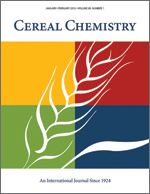
Cereal Chem 61:187 - 192. | VIEW
ARTICLE
Factors Affecting Rancidity in Ground Pearl Millet (Pennisetum americanum L. Leeke).
I. Kaced, R. C. Hoseney, and E. Varriano-Marston. Copyright 1984 by the American Association of Cereal Chemists, Inc.
Increases in fat acidity and peroxide value show that pearl millet rapidly becomes rancid after it is ground. Fat acidity and peroxide value of stored whole pearl millet grain did not vary significantly over the same time period, showing that deterioration occurs more rapidly in ground millet than in whole grain. When millet meal was stored in polyethylene bags, the peroxide value increased rapidly and appeared to signal the start of rancidity. However, millet meal stored in cotton bags showed no peroxide accumulation. This may suggest that the procedure measures unknown volatiles and not peroxides. Free fatty acids and fat-acidity data indicated that all the acidity produced during storage was the result of free fatty acids. The proportions in which free fatty acids were released were similar to those found in total fatty acids. Therefore, the hydrolytic action of lipase appeared to be random. Total fatty acids did not significantly change as a result of storage. Thus, no significant oxidative degradation of fatty acids occurred during the storage period. Under high relative humidity (80%), fat acidity increased drastically during the first few days of storage and then leveled off. No explanation is offered for the leveling off. Hexanal is a major product of oxidative degradation of lipids. No hexanal was produced in millet meal stored for 15 days in polyethylene bags. As in other cereals, hexanal increased after 21 days of storage. However, this does not correlate well with the rancid ordors and flavors found earlier during storage of pearl millet. Thus, the peroxide value obtained after short storage may not be the result of the classical oxidative degradation of lipids. Reconstitution studies of millet meal and whole wheat meal and their lipids showed that fat content was the major factor contributing to the rapid increase of fat acidity in ground millet. When the same leve l of fat was used, the increase in fat acidity was significantly higher for samples containing wheat lipids than for those containing millet lipids. Lipase appeared to be more active in defatted millet than in defatted wheat.